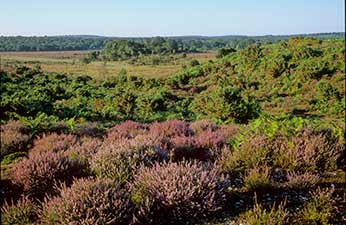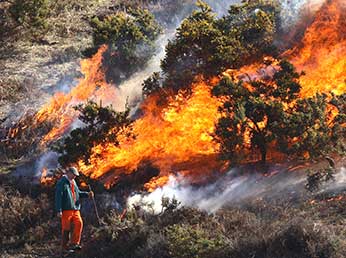Heathlands

Is there any more pleasing sight in the natural world than wide expanses of golden, yellow flowered gorse in early spring stretching across the landscape as far as the eye can see; or vast swathes of heather dressed in the rich purples of August and September; or myriad glistening spiders' webs bedecked in dew, festooned at dawn on heathland vegeation? Almost certainly not!
Welcome, then, to the New Forest heathlands, magnificent landscapes and wonderful places to find wildlife, much of it rare or threatened elsewhere.
Tiny Dartford warblers and usually more conspicuous stonechats are present all the year round – the New Forest heathlands hold a large percentage of the national Dartford warbler population, and are important for stonechats, too - whilst linnets and meadow pipits are present for much of the year.
In spring and summer, nightjars churr in the gloom, enlivening New Forest heathlands with wing clapping displays and buoyant, acrobatic hunting flights; whilst by day, hobbies soar aloft on scimitar-shaped wings, searching for insect prey; cuckoos declare presence with their familiar calls in-between staking out meadow pipit nests in which to lay their eggs. Tree pipits, albeit in relatively small numbers, are also present at this time of year and so, too, are the far commoner and more widespread willow warblers.
In autumn and winter, great grey shrikes perch atop gorse and birch, ever-watchful, waiting to pounce on unsuspecting bird or beetle; and hen harriers quarter the ground in low, languid, flapping flight, hunting for their own small bird and mammal prey. Look out also for Merlins, tiny falcons that in early autumn flee upland breeding areas to enjoy the milder climate of the New Forest.
Reptiles are active in the warmer months – adders, common lizards and the incredibly rare sand lizard, imparting to these New Forest Heathlands an ambience more often found in southern Europe.
Lousewort, milkwort, heath bedstraw, heath spotted-orchids and tormentil all add colourful variety, whilst concealed amongst the bracken around the heathland margins can sometimes be found the beautiful purple blooms of the wild gladiolus, a species in Britain restricted to the New Forest.
Dragonflies and damselflies in spring and summer visit from adjacent wetlands, patrolling the heaths in search of insect prey; in May and June, colonies of tiny, green hairstreak butterflies may be seen amongst the gorse; whilst in July and early August, silver-studded blue butterflies, rare creatures in much of Britain, are on the wing in impressively large numbers. And then from mid-July until the end of September, Grayling butterflies emerge.
And so the list goes on, a roll call of species that once were common and widespread in much of England. But no more, for many lowland heaths elsewhere have disappeared under carpets of concrete, have been lost to agriculture or else have simply been neglected and are now overgrown by scrub.
Yet here in the New Forest, there is still much to enjoy, despite local losses to 19th century, and earlier, forestry inclosures. Indeed, it has been estimated that Hampshire has around 1/3 of Britain’s remaining lowland heathland, of which a large proportion is in the New Forest.
So here heathland remains, maintained by deer, commoners’ ponies and other stock animals, natural lawn mowers that through grazing help keep these wonderful places clear of the encroaching vegetation - such as such as Scots pine, birch and invasive shrubs - that would otherwise invade and start the natural succession to woodland.
The animals, though, need a little help, so stubbornly invasive species are removed by man during the Forestry Commission’s annual cutting and controlled rotational burning programmes.

New Forest heathland burning usually takes place from late-February to the end of March, towards the end of the October-March legally permitted period. Then, the worst of the winter weather is usually over, vegetation is likely to be quite dry, still-wet ground offers protection to the peaty soil, and the impact on wildlife, particularly breeding birds and reptiles, is minimised.
Around 36 hectares of heathland are cut annually, compared to 400 hectares burnt, always in widely separated, relatively small blocks that create habitat diversity and ensure that places for wildlife remain untouched nearby.
In fact, a number of wildlife species benefit from the process. Woodlarks, for example, do well on newly bare ground, marsh gentians enjoy reduced competition from more vigorous plants, and reptiles and insects benefit from the ‘edge’ effect created.
And the stock also benefit. Fresh growths of purple moor grass are stimulated, whilst tough, old gorse and heather stems are destroyed, encouraging the regeneration or seeding of tasty young replacements that will go on to form an important part of the animals’ diet, particularly during the winter months when many other foods are not readily available.
References:
Hampshire’s Countryside Heritage, Heathland: Hampshire County Council
Heathlands: Nigel Webb
The New Forest – A Natural History: Colin R. Tubbs
More links
Other related links
Search this site

Sadly, 58 animals were killed - 35 ponies, 13 cows, 8 donkeys and 2 sheep, whilst a further 32 were injured - 3 pigs, 9 donkeys, 11 cows and 9 ponies.
(Forty-three accidents occurred in daylight, 15 at twilight and 101 in the dark. Twenty-seven accidents were not reported by the driver involved).
Here's just one horrific example - Three donkeys killed in collision with van at notorious New Forest blackspot (Advertiser and Times)
Sika deer continue to engage in rutting behaviour, and will do so until December.
Pigs seek out the remains of the acorn crop.
Beech leaves are transformed into a magnificent mosaic of glorious reds and golds. Other deciduous trees, too, take on an autumnal cloak before their leaves fall.
Dragonflies can occasionally be seen on the wing on bright days early in the month.
December
Foxglove leaves survive the winter at ground level, and offer the prospect of colourful summer blooms to come.
Redwings and fieldfares, autumn and winter visitors, gorge on haws and holly berries.
Great grey shrikes and hen harriers hunt over the heaths and other open spaces.
Honeysuckle by the end of the month often shows welcome signs of new growth.

